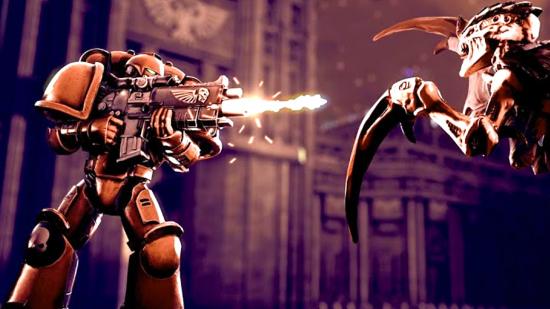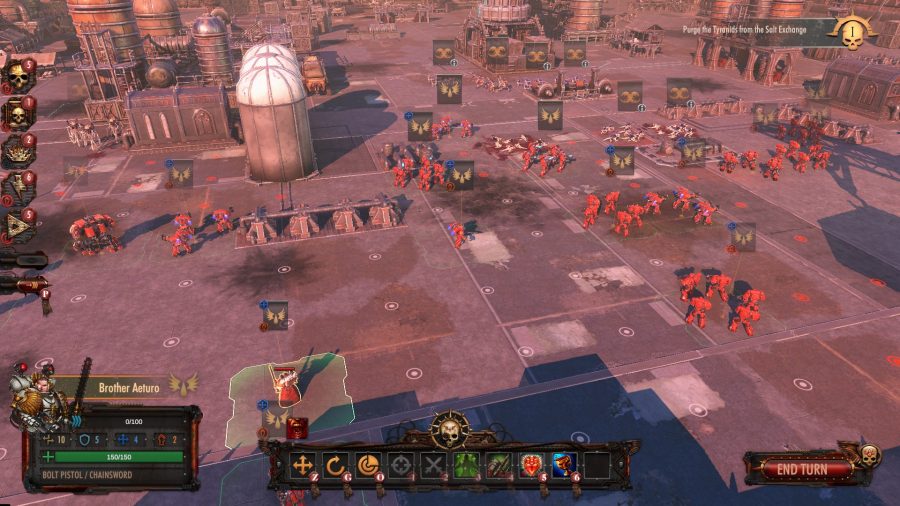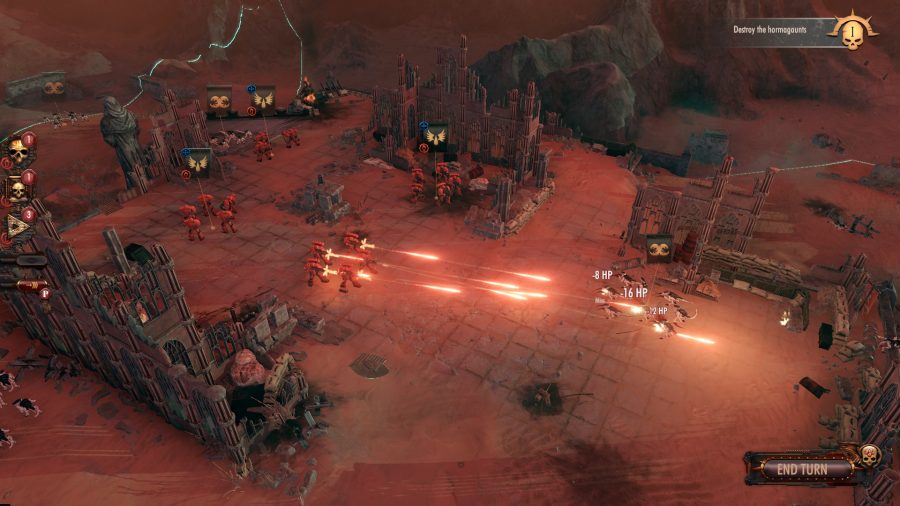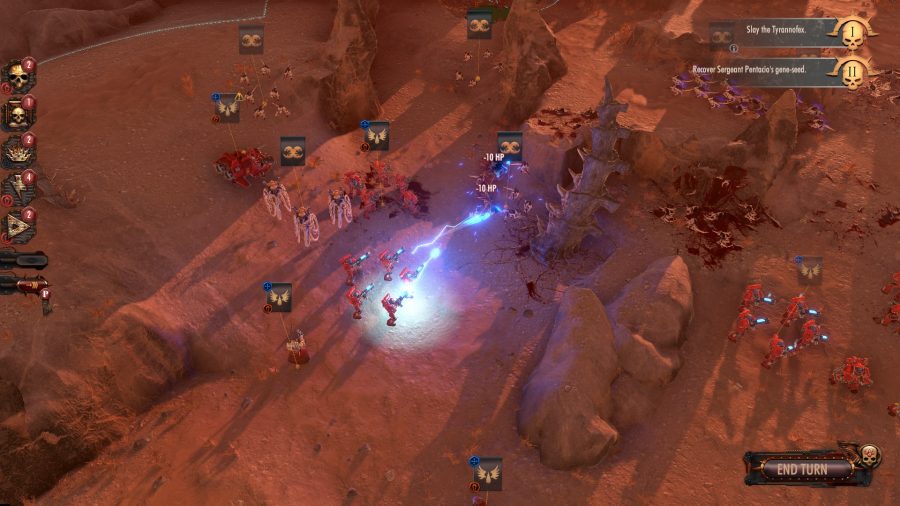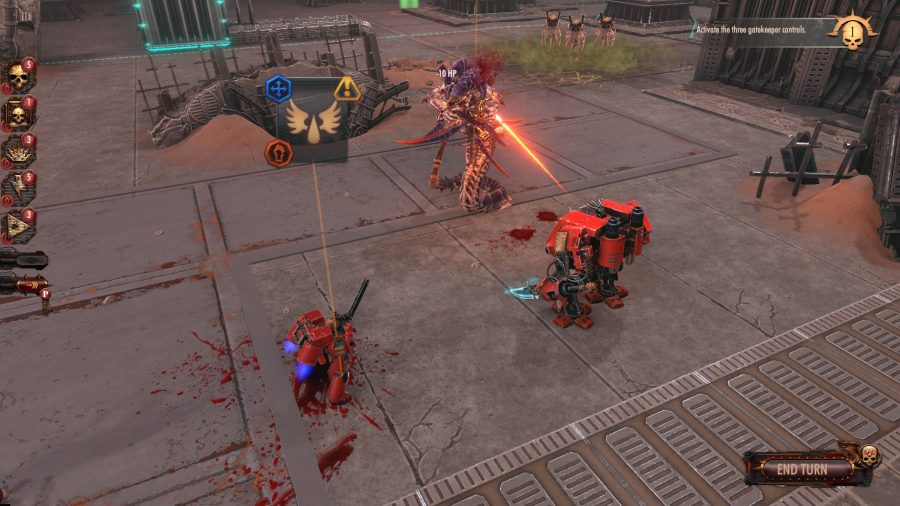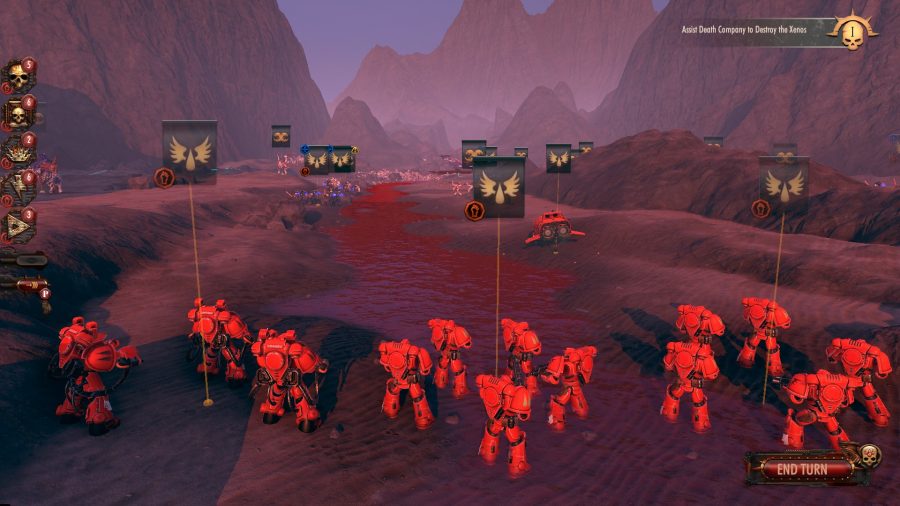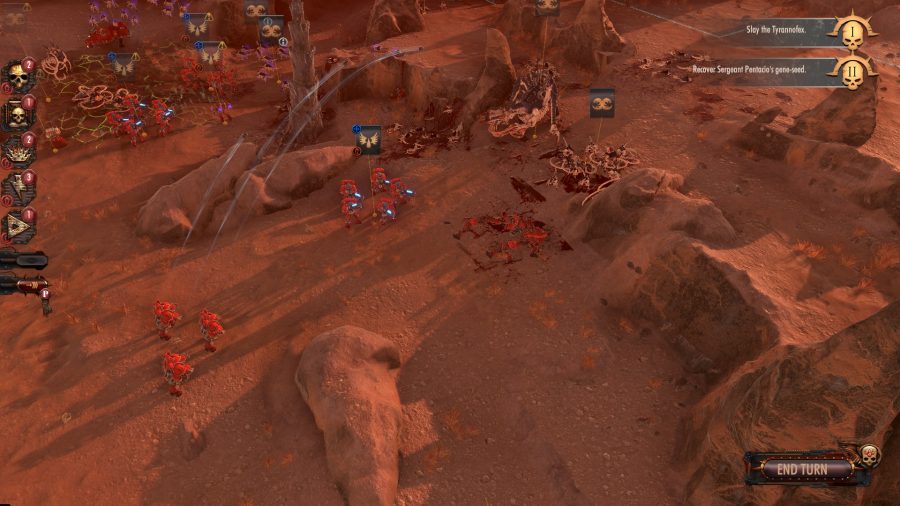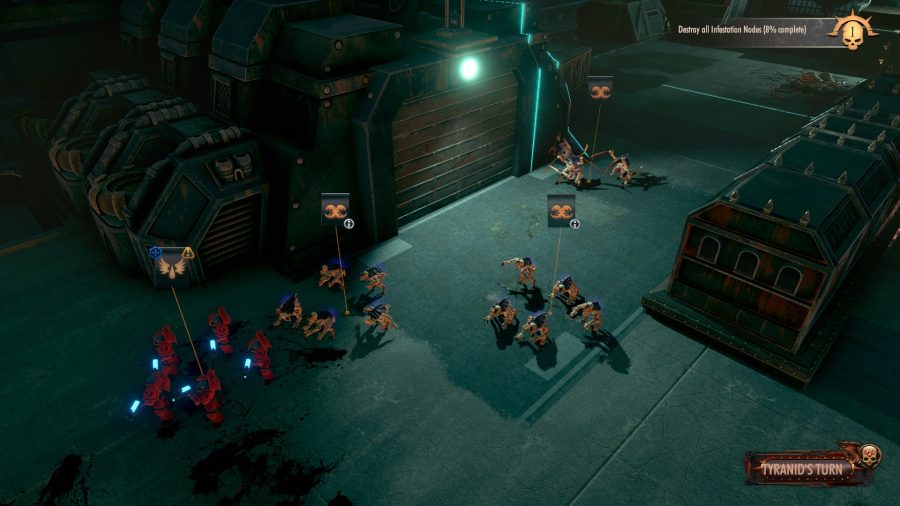Warhammer 40K has always embraced exaggerated, exultant violence and action. Even to the uninitiated, the hulking power armour of the ‘noble’ Space Marines, and the buzzing teeth of their trusty chainswords speak to the stylised ferocity of the grimdark future’s Forever War. Moving off the tactile tabletop and onto the PC screen brings more vivid visuals to the flamers melting Greenskin flesh, or meltaguns cooking the plate armour of some twisted warp-entity – but it comes with challenges of its own.
It’s this kind of aggressive, bloodthirsty action that developer Black Lab hopes to replicate in its recently-announced strategy game, Warhammer 40K Battlesector. Or, as founder and head of Black Lab Games Paul Turbett tells us, the game should “feel real, feel grungy, meaty, and like you’re in the battle”.
To truly recreate the aggressive rush of combat is a tall order, even in a AAA-budgeted first-person shooter, but Battlesector faces an additional hurdle – it’s a turn-based strategy game. When publisher Slitherine announced Battlesector would sell itself on “fierce, fast-paced combat”, eyebrows were understandably raised. Tactically manoeuvring squads of Blood Angels across a skirmish battle-grid to outflank groups of Tyranids in the drawn-out staccato of a turn-based squad tactics game doesn’t naturally lend itself to portraying the sprees of fluid, kinetic destruction described in 40K fiction. Nevertheless, Black Lab has a plan.
“It’s all about relativity to the norms of a turn-based game,” explains Turbett. “There are some turn-based wargames where it takes two hours to have a turn, with hex grids, and counters, and a lot of detail.
“We’re on the other end of the spectrum to that. You’re not stuck waiting for things to happen, you’re always able to be giving commands, to keep the game moving forward.”
Part of this comes through the rhythm of gameplay and creating a persistent flow of player involvement. During unit movement and action, the player can hop between squads on the fly, dishing out commands to some units, while the actions of others on the opposite side of the battle are still resolving. While not the full-blown real-time/turn-based strategy hybrid of Black Lab’s last offering, Battlestar Galactica Deadlock, Turbett hopes it’ll provide players more consistent decision-making and immediate feedback than many turn-based games.
“It’s always flowing,” he says; “Things are always moving.”.
“If you want to stop and take a bit of step back, think about it, you can do that. But if you want to just get a whole bunch of things happening, you can do that as well – the game’s not gonna get in your way.”
More substantially, Battlesector’s action is driven by combat mechanics that encourage brazen player aggression. Through a ‘momentum system’, units are rewarded for their active engagement in combat, and provided upgrade points for leaping into the fray.
Aping the Blood Angels’ ‘Red Thirst’ of 40K lore – a genetic fault that makes the Blood Angels and their successor Space Marine chapters crave the blood of others – units engaged in combat will rapidly increase in momentum points to spend on additional actions or upgrades. Pull back from the frontlines, and watch your momentum plummet, along with whatever combat advantages it provided.
Rights of Man: Our Warhammer 40K: Imperium factions guide
Turbett gives the example of a Sanguinary priest that upgrades their healing after a bloody melee encounter, or a squad of Intercessors that temporarily improve their accuracy and firepower after a brawl. Keep them out of combat or rely too much on their defensive abilities, and they’ll soon be overrun by the buffed aggression of the tireless Tyranid swarm; keep them constantly on the frontlines and you’ll be rewarded with bonuses.
“It’s about incentivising moving forward and always taking the fight to the enemy,” says Turbett. “It’s especially rewarding players for being active, and partly came out of trying to avoid the whole turtling thing where someone sits back in overwatch and waits for others to come.”
embracing the melee
Of course, no game set in the grim darkness of the far future could appropriately recreate its bloody aggression without capturing its tone. In Battlesector’s case, that means a healthy dollop of bloody gore.
“We’ve turned the blood up to 11,” says Turbett. “Flying limbs we haven’t done, but a few other things are needed to do before getting to that stuff.
“We’re definitely making sure we’ve got a good layer of grimdark through the environments,” he added. Expect lots of dead Space Marines, fallen in the devastation of Baal, littering the battlefield.
The emperor’s finest Boys In Red aren’t the only ones prone to unbridled aggression. The fearsome insectoid Tyranids, playable in the game’s Skirmish mode, though not in the central campaign, must also satiate their ‘Endless Hunger’ by diving straight into the fight at every opportunity. You’ll soon find your hormagaunts helpless against the offensive capabilities of the Blood Angels, if left out of the fight and unable to accrue those crucial momentum bonuses.
In a nod to their playstyle on the tabletop, players are also encouraged to stick Tyranid units close together and leverage their ‘Swarm Tactics’ ability, which provides bonuses to whole swathes of Tyranid forces when in proximity. The devout followers of the Emperor, however, are handed abilities that bolster the combat stats of individual units, able to slaughter hordes of parasitic Tyranids alone.
As well as being borne out in Battlesector’s mechanics, Turbett says the game’s melee focus is also meant to lean into 40K’s grim, ultraviolent aesthetic.
The Warp beckons: Read our 40K Chaos factions guide
While XCOM, and similar squad-based tactical shooters that have experienced a renaissance in the last few years, have focused heavily on calculated ranged gameplay, Turbett reckons the close-combat focus of Battlesector better recreates the cadence of combat in the 41st millennium.
In-keeping with their famous penchant for melee armaments on the tabletop, Blood Angels fans can expect to see a bunch of their chapter’s beloved close-combat weapons recreated in-Battlesector – from the Encarmine swords of the Sanguinary Guard to the mighty, dumpster-sized power fists of Furioso Dreadnoughts.
“Quite often, you’ll do a lot of detailed design on ranged combat and its mechanics,” says Turbett. “We wanted to make sure that melee had the same amount of weight in terms of options you’ve got; the same depth to the systems. Melee combat needs to feel dangerous, and it should feel meaty.”
“When you go in and do an attack, it’s very high damage, but there’s also a reaction. So that means that there’s a degree of danger in doing that,” he added.
“If I’m going to shoot you with a bolt pistol from a little way away, compared to cutting you with a chainsword, the chainsword is immediately going to do more damage, but it comes with a bit more risk as well.”
persistent action
Part of this risk comes through automatic fighting mechanics. Units engaged in close combat will receive an ‘attack of opportunity’ against fleeing enemies, and ranged units can hunker down in an overwatch-esque ‘engaged state’ to shoot down any squad that attempts to fall back. Similarly, both melee and ranged units possess proximity-bound ‘zones of control’ over their adjacent tiles, automatically attacking any enemy unit that walks through their zone.
These additional, automatic actions encourage players to keep their squads on the attack. It’s often more rewarding to aggressively plunge forward through enemy lines, rather than skirting around them or fleeing back to cover and incurring the damage cost.
At launch, Blood Angels and Tyranids will be the only factions to make an appearance in Battlesector, but Turbett hints that more factions and playable races could be on the way post-launch. He says updates for Battlesector will likely take on a similar rhythm to Black Lab’s previous release Battlestar Galactica Deadlock – providing additional content over several years to match players’ interests and community direction.
Battlesector’s beta-testing sign-ups are now live and the game expected to release this May, although the precise side of the month is up in the air: “We’ll progress through the beta, and then make a decision about what’s the best time to release it based on how we’re going with getting the game right.”
Battle-ready: Read our Warhammer 40K codex release date guide
That beta will be Black Lab’s chance to show it’s successfully transported the ridiculously overstated, gore-soaked kill-fest of 40K into the regimented environs of a turn-based strategy game. Only time will tell if Battlesector earns eternal glory in the eyes of the God-Emperor, or gets left for carrion, to be subsumed into the Tyranid Hive Fleets.
